Related Research Articles
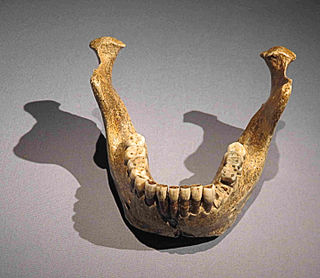
Homo heidelbergensis is an extinct species or subspecies of archaic human which existed during the Middle Pleistocene. It was subsumed as a subspecies of H. erectus in 1950 as H. e. heidelbergensis, but towards the end of the century, it was more widely classified as its own species. It is debated whether or not to constrain H. heidelbergensis to only Europe or to also include African and Asian specimens, and this is further confounded by the type specimen being a jawbone, because jawbones feature few diagnostic traits and are generally missing among Middle Pleistocene specimens. Thus, it is debated if some of these specimens could be split off into their own species or a subspecies of H. erectus. Because the classification is so disputed, the Middle Pleistocene is often called the "muddle in the middle".
A manuport is a natural object that has been deliberately taken from its original environment and relocated without further modification. Typically moved by human hand, some manuports are the result of other hominins. Common manuports include stones, seashells and fossils, which has led archaeologists and anthropologists to conclude they must have been chosen for their beauty. This recognition of an object’s aesthetic character suggests that certain manuports represent some of the earliest examples of art.

The Bhimbetka rock shelters are an archaeological site in central India that spans the Paleolithic and Mesolithic periods, as well as the historic period. It exhibits the earliest traces of human life in India and evidence of the Stone Age starting at the site in Acheulian times. It is located in the Raisen District in the Indian state of Madhya Pradesh, about 45 kilometres (28 mi) south-east of Bhopal. It is a UNESCO World Heritage Site that consists of seven hills and over 750 rock shelters distributed over 10 km (6.2 mi). At least some of the shelters were inhabited more than 100,000 years ago.

The Venus of Tan-Tan is an alleged artifact found in Morocco. It and its contemporary, the Venus of Berekhat Ram, have been claimed as the earliest representations of the human form.
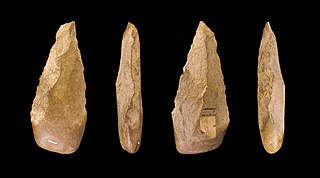
The Lower Paleolithic is the earliest subdivision of the Paleolithic or Old Stone Age. It spans the time from around 3.3 million years ago when the first evidence for stone tool production and use by hominins appears in the current archaeological record, until around 300,000 years ago, spanning the Oldowan and Acheulean lithics industries.

An orthocone is the long, cone-shaped shell belonging to several species of ancient nautiloid cephalopod—the prehistoric ancestors of today's marine cephalopod mollusks, including the cuttlefishes, nautili, octopi and squids. During the 18th and 19th centuries, all such shells discovered were given the "catch-all" name Orthoceras, thus creating a wastebasket taxon. However, it is now known that many species, genera and families of nautiloids developed or retained this form of shell.
Gudrun Corvinus (1932–2006) was a German geologist, paleontologist and archaeologist. Her contributions through her field work, academic monologues and archeological excavation discoveries are vast and have contributed to continued scientific discoveries. Corvinus’ work gained professional recognition prior to her murder that took place in her home in Pune, India, on 7 January 2006.
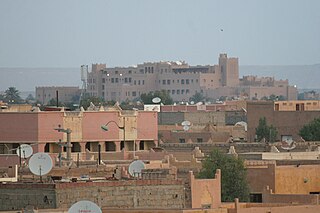
Erfoud is an oasis town in the Sahara Desert, in the Drâa-Tafilalet region, eastern Morocco. It belongs to ait atta tribe, divided into several districts: Hay Salam, Hay Jdid, Hay Ziz, Hay el Bathaa, Hay Annahda, and Hay el Hamri.

The South Asian Stone Age covers the Palaeolithic, Mesolithic and Neolithic periods in the Indian subcontinent. Evidence for the most ancient Homo sapiens in South Asia has been found in the cave sites of Cudappah of India, Batadombalena and Belilena in Sri Lanka. In Mehrgarh, in western Pakistan, the Neolithic began c. 7000 BCE and lasted until 3300 BCE and the Chalcolithic and early Bronze Age. In South India, the Mesolithic period lasted until 3000 BCE, and the Neolithic period until c. 1000 BCE, followed by a Megalithic transitional period, mostly skipping the Bronze Age. The Iron Age in India began roughly simultaneously in North and South India, around c. 1200 to 1000 BCE.

Phosphatodraco is a genus of azhdarchid pterosaur that lived during the Late Cretaceous of what is now Morocco. In 2000, a pterosaur specimen consisting of five cervical (neck) vertebrae was discovered in the Ouled Abdoun Phosphatic Basin. The specimen was made the holotype of the new genus and species Phosphatodraco mauritanicus in 2003; the genus name means "dragon from the phosphates", and the specific name refers to the region of Mauretania. Phosphatodraco was the first Late Cretaceous pterosaur known from North Africa, and the second pterosaur genus described from Morocco. It is one of the only known azhdarchids preserving a relatively complete neck, and was one of the last known pterosaurs. Additional cervical vertebrae have since been assigned to the genus, and it has been suggested that fossils of the pterosaur Tethydraco represent wing elements of Phosphatodraco.
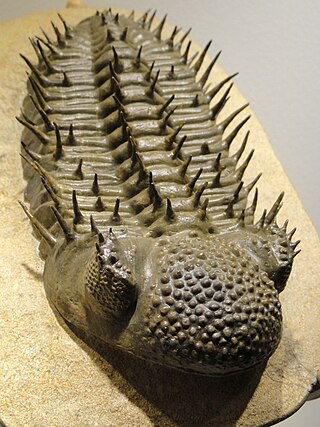
Drotops is a genus of trilobites from the order Phacopida, family Phacopidae that lived during the Eifelian of the Middle Devonian. It was described by Struve in 1990 under type species Drotops megalomanicus. Their fossils are found in present-day Morocco, specifically the Maïder Region located South West of Erfoud.
Gladysvale Cave is a fossil-bearing breccia filled cave located about 13 kilometres (8.1 mi) northeast of the well-known South African hominid-bearing sites of Sterkfontein and Swartkrans and about 45 kilometres (28 mi) north-northwest of Johannesburg, South Africa. It is situated within the Cradle of Humankind World Heritage Site and is itself a South African National Heritage Site.
The Soanian culture is a prehistoric technological culture from the Siwalik Hills, Pakistan. It is named after the Soan Valley in Pakistan.

Belemnitella is a genus of belemnite from the Late Cretaceous of Europe and North America. Belemnitella was a squidlike animal, probably related to the ancestors of modern squids and cuttlefish. The shell was internal. The rostrum or guard is found the most often and possesses a distinctive slit at its ventral surface and a ridge on the dorsal surface. The phragmocone has a small protoconch at its tip, and fit into the cavity and the guard. It also had septa and a ventral siphuncle within the phragmocone, projecting forward as a beak-like blade.

Makapansgat is an archaeological location within the Makapansgat and Zwartkrans Valleys, northeast of Mokopane in Limpopo province, South Africa. It is an important palaeontological site, with the local limeworks containing Australopithecus-bearing deposits dating to between 3.0 and 2.6 million years BP. The whole Makapan Valley has been declared a South African Heritage Site. Makapansgat belongs to the Cradle of Humankind.

Cuttlefish, or cuttles, are marine molluscs of the suborder Sepiina. They belong to the class Cephalopoda which also includes squid, octopuses, and nautiluses. Cuttlefish have a unique internal shell, the cuttlebone, which is used for control of buoyancy.

The Makapansgat pebble or Makapansgat cobble is a pebble with natural chipping and wear patterns that make it look like a crude rendition of a human face, in fact at least two possible faces. Some scholars argue that it is the oldest known manuport.
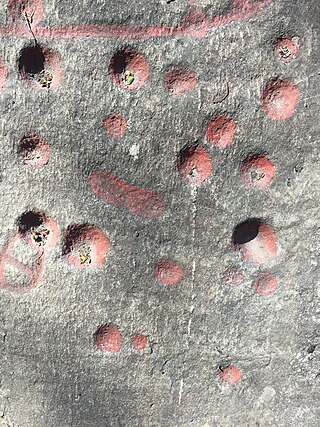
Rock cupules are artificially made depressions on rock surfaces that resemble the shape of an inverse spherical cap or dome. They were made by direct percussion with hand-held hammer-stones, on vertical, sloping or horizontal rock surfaces. Cupules are widely believed to be the world's most common rock art motifs, found in huge numbers in every continent except Antarctica. They were produced in many cultures, from the Lower Paleolithic to the 20th century, and they can be found on most lithologies. Similar artifacts from lithic Native American cultures are also known as cupstones.

Afrotapejara is an extinct genus of tapejarid pterosaur discovered in Morocco. The type species, Afrotapejara zouhri, was named and described in 2020. It was the first tapejarid discovered in Africa and the fourth pterosaur discovered in the Kem Kem Beds.

The Moroccan fossil trade is the large industry surrounding the excavation, preparation and international sale of fossils from Morocco. Morocco contains some of the world's richest fossil sites and has seen international interest from fossil collectors since the early 20th century. As interest in collecting fossils grew in the late 20th century, the Moroccan fossil trade grew into a lucrative industry of its own. More than 50,000 Moroccans earn their living in mining, trading or exporting fossils and the industry itself is worth more than $40 million annually. The booming industry is so big that some commentators have referred to it as "fossil capitalism" or a "trilobite economy".
References
- 1 2 3 Bednarik, Robert (2002). "An Acheulian palaeoart manuport from Morocco". Rock Art Research. 19 (2).